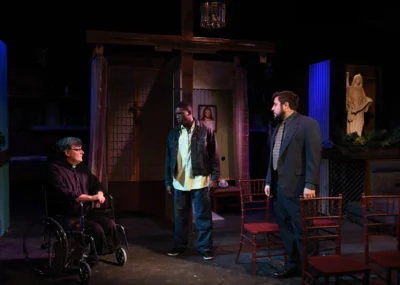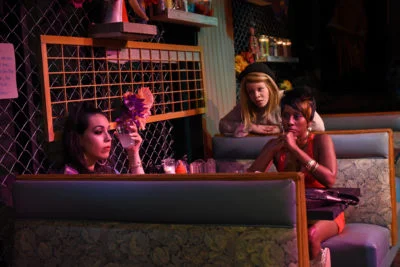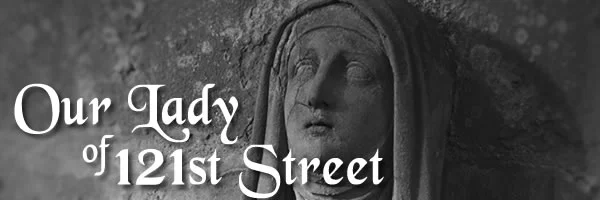Our Lady of 121st Street

By Stephen Adly Guirgis
Directed by Sarah Moeller
Produced by Eclipse Theatre Company, Chicago
An Actor’s Piece Becomes and Ensemble’s Piece
Stephen Adly Guirgis’s early work Our Lady of 121st Street, which debuted in 2002, is one of the most popular sources of scenes and monologues for actors in training. With a large, diverse cast of troubled and bizarre characters, it provides ample opportunity for performers to make memorable impressions in just a few minutes. The play is also a snapshot of a community, instead of a traditional story, and therefore, it’s interesting to see how a professional production handles it. In the second production of Eclipse Theatre Company’s Guirgis season, director Sarah Moeller rises to the challenge of placing twelve actors on a studio stage filled with realistic depictions of multiple locations, creating a piece that is multifaceted, yet unified.

The setting is the funeral of Sister Rose, a nun and Catholic elementary school teacher who, according to which of her former students you ask, was either a saint who repented for her father’s drunken brutality through a lifetime of service, or a rod-wielding “penguin bitch” who died of alcoholism. The plans for her interment are disrupted when her corpse is stolen, along with one of the mourner’s pants, leaving a group of people in their thirties to forties who are mostly estranged from each other to awkwardly mill around the vicinity of a church and nearby bar, hoping the police will find their former teacher before they have to bury an empty box.

Among the mourners are celebrity DJ Rooftop (Bernard Gilbert), who is hiding in a confessional from his ex-wife, Inez (Celeste M. Cooper), who he cheated on with Norca (Paloma Nozicka), a mentally unbalanced woman who is famous for her nastiness. Gilbert builds a hilarious serious of sense with Gary Simmers, who plays Father Lux, the priest Rooftop irritates and fascinates, despite the priest’s reluctance to seriously engage with his changed neighborhood. However, the most outrageous humor in the play comes from the confrontation between Inez and Norca in the bar, which somehow results in Norca assaulting Sonia (Ashley Hicks), a hapless and otherwise uninvolved woman who simply happened to overhear Norca’s whining that everybody always sides against her simply because of the things she does and the way she treats them.

Other alumni of Sister Rose’s school include: Flip (Gregory Geffrard), a closeted Wisconsin lawyer, and his irrepressible white boyfriend, Gail (Matt Thinnes); Edwin (Anthony Apodaca), who accidently hit his brother, Pinky (Rudy Galvan), in the head with a brick as a child, and has been caring for the brain-damaged man ever since; Rose’s neurotic, asthmatic niece, Marcia (Kristen Johnson) and grievously offended and pantsless friend, Victor (Kevin Scott); and traumatized, alcoholic detective Balthasar (Todd Garcia). As funny as many of the scenes of people behaving badly are, the ones involving mental illness are quite sad or disturbing. An extremely dark moment comes early in the show when, during a detainment of extremely questionable legality, Balthasar describes in sickening detail to Norca what is going to happen to her if she is involuntarily committed and put on medications. In a similar scene near the end, a frightened and exasperated Edwin confronts Pinky with a lifetime’s worth of resentment, which Pinky is, of course, incapable of comprehending. Galvan is especially fine here, but the nature of Our Lady is to give each of its actors opportunities for brilliance, and all take them.

The common complaint about this show, besides Guirgis’s making his characters far more eloquent than they could ever hope of being in real life and his immature religiosity, which is common to all his early works, is that these episodic scenes are more amusing for actors than for audiences. That’s the concern Moeller and her design team seem to have been determined to address. Scenic designer Kevin Hagan has centered the confessional booth against the back wall, with booths from the bar flanking the stage, and the room with the coffin in the front. Besides allowing lighting designer Mike Winkelman to blanket the set in soft lighting appropriate for bars and shrines, this has also allowed Moeller to keep most of the characters onstage even when they’re not in the room being focused on. Therefore, instead of Gail and the like disappearing for over an hour at a time, a sense of community between the characters is upheld, and each of their emotional journeys is allowed to happen more fully before the audience than they would have otherwise. Moeller’s staging transforms what could have been a random series of scenes with little appeal into an ensemble drama. While Steppenwolf is producing Guirgis’s recent Pulitzer Prize winner, Between Riverside and Crazy, Chicago audiences also have a chance to see what could be the best-possible production of one of the early works which made his fame.
Recommended
Jacob Davis
Reviewed July 17, 2016
This show has been Jeff recommended.
For more information, see Our Lady of 121st Street’s page on Theatre in Chicago.
Playing at the Athenaeum Theatre, 2936 N Southport Ave, Chicago. Tickets are $20-30; to order, call 773-935-6875 or visit eclipsetheatre.com Performances are Thursdays-Saturdays at 7:30 pm and Sundays at 2:00 pm through August 21. Running time is two hours and thirty minutes with one intermission.

